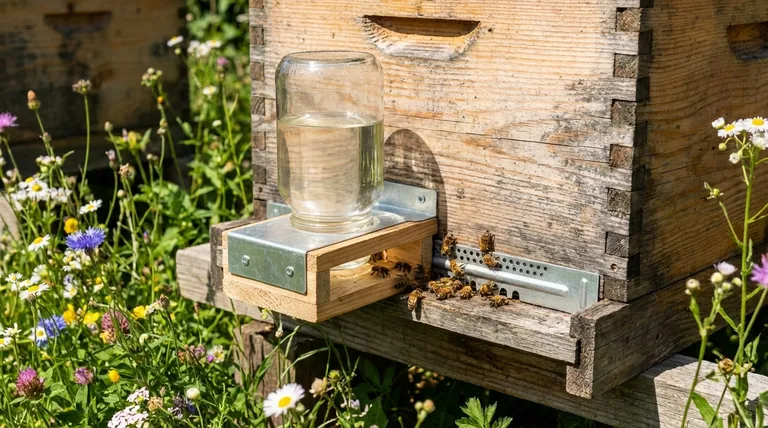For new beekeepers, the most accessible and common option is an entrance feeder, also known as a Boardman feeder. This simple device consists of a base that slides into the hive's main entrance and holds an inverted jar of sugar syrup. Its primary advantage is allowing you to monitor food levels and refill the jar without opening the hive and disturbing the colony.
While the entrance feeder is valued for its simplicity, it introduces significant risks like attracting pests and promoting "robbing" from other hives. Understanding this trade-off is the first step toward effectively managing your colony's health.

Why We Feed Bees in the First Place
Supplemental feeding is a critical management tool, not a replacement for natural forage. Beekeepers typically feed colonies to provide nutritional support during specific, stressful periods.
To Establish a New Colony
A newly installed package or nuc of bees has a monumental task: building wax comb, raising brood, and gathering resources. Providing sugar syrup gives them the energy needed to build their home quickly and establish a strong population.
During a Nectar Dearth
Sometimes there is a gap in the season when few nectar-producing plants are in bloom. This "nectar dearth" can starve a colony, and feeding helps them bridge the gap until natural sources become available again.
To Prepare for Winter
In colder climates, colonies need significant honey stores to survive the winter. If they haven't stored enough by fall, beekeepers provide heavy syrup to help them build up the necessary reserves.
The Entrance Feeder: A Beginner's Go-To
The entrance feeder is often included in beginner beekeeping kits for a reason. Its design is intuitive and its operation is straightforward.
How It Works
The feeder's base has a channel that allows bees to access the syrup through small holes in the jar's lid. The vacuum pressure inside the inverted jar prevents the syrup from pouring out all at once.
Key Advantage: Visibility
The greatest benefit is the ability to see the syrup level from a distance. You know exactly when it needs a refill without having to suit up and open the hive, which minimizes stress on both you and the bees.
Key Advantage: Ease of Use
Refilling the feeder is as simple as swapping an empty jar for a full one. This can be done in seconds, at any time of day, with minimal disturbance to the colony's activity.
Understanding the Trade-offs: Simplicity vs. Security
The very feature that makes the entrance feeder convenient—its external placement—is also its biggest liability. This is a critical factor that beginners must understand to prevent major problems.
The High Risk of Robbing
The smell of sugar syrup right at the hive entrance is an open invitation to robber bees from stronger nearby hives, as well as wasps and ants. This can trigger a "robbing frenzy," where the invading insects overwhelm your colony's guard bees, steal all their food stores, and potentially kill the queen.
Limited Capacity
A standard Mason jar holds a relatively small amount of syrup. A strong, rapidly growing colony can empty it in less than a day, requiring constant refilling that can become a significant chore.
Exposure to the Elements
Being outside the hive, the syrup is exposed to temperature fluctuations. It can get too cold for bees to consume or become too hot and ferment in direct sunlight.
Making the Right Choice for Your Hive
As a technical advisor, my goal is to empower you to make an informed decision based on your specific situation and management style.
- If your primary focus is simplicity and frequent hive checks: The entrance feeder is an acceptable tool to start with, but you must be extremely vigilant for signs of robbing.
- If your primary focus is colony health and security: Consider using an internal feeder, such as a frame feeder or top feeder, which holds more syrup and keeps the food securely inside the hive, drastically reducing the risk of robbing.
Ultimately, choosing the right feeder involves weighing convenience against the well-being of your colony.
Summary Table:
| Feature | Description |
|---|---|
| Best For | New beekeepers, frequent hive checks |
| Primary Advantage | Easy to monitor and refill without opening the hive |
| Key Risk | High potential for attracting robber bees and pests |
| Capacity | Limited (e.g., a standard Mason jar) |
| Placement | External, at the hive entrance |
Equip Your Apiary with Confidence
Choosing the right feeder is just the beginning. Proper equipment is fundamental to successful colony management. HONESTBEE supplies commercial apiaries and beekeeping equipment distributors with high-quality, durable beekeeping supplies through our wholesale-focused operations.
Let us help you build a stronger, more productive operation. Our experts can provide the reliable equipment your business depends on.
Contact HONESTBEE today for wholesale inquiries and expert support.
Visual Guide

Related Products
- Boardman Entrance Bee Feeder Durable Galvanized Steel and Wood Construction for Beekeeping
- Classic Boardman Entrance Bee Feeder Hive Front Feeding Solution
- HONESTBEE Entrance Bee Feeder Professional Hive Nutrition Solution for Beekeeping
- HONESTBEE Professional Entrance Bee Feeder Hive Nutrition Solution
- Professional Hive Front Entrance Bee Feeder
People Also Ask
- How does a bee entrance feeder work? A Simple Guide to Convenient Hive Feeding
- Are entrance feeders good for bees? Prioritize Hive Health Over Convenience
- How does an entrance feeder work? A Guide to Its Simple Mechanics and Risks
- What are the different types of feeders available for beehives? A Guide to Entrance, Hive-Top, and Frame Feeders
- What is an entrance feeder? A Guide to Its Simple Design and High Robbing Risk



















